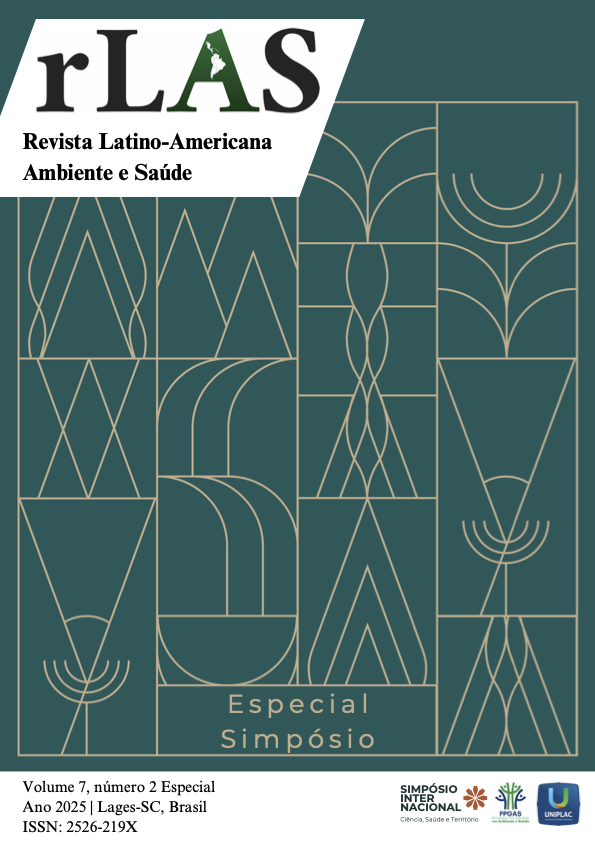Bone fractures: biological complexity and therapeutic advances with nanotechnology
Keywords:
Fracture, Bone formation, NanoparticleAbstract
Bone fractures represent a significant public health challenge, especially in contexts of population aging and increasing high-energy trauma. Bone repair is a complex biological process involving multiple cell types, molecular signaling, and interactions with the tissue microenvironment. Given the limitations of traditional treatment methods, such as autologous or synthetic grafts, nanotechnology emerges as a promising alternative. This review discusses the cellular mechanisms of osteogenesis, the difficulties faced in cases of complex fractures, and the therapeutic advances associated with the use of bioactive nanoparticles as tools to stimulate bone regeneration.
References
CUMMINGS, S. R.; MELTON, L. J. Epidemiology and outcomes of osteoporotic fractures. The Lancet, London, v. 359, n. 9319, p. 1761–1767, 2002. DOI: https://doi.org/10.1016/S0140-6736(02)08657-9.
DIMITRIOU, R. et al. Bone regeneration: current concepts and future directions. BMC Medicine, London, v. 9, n. 66, 2011. DOI: https://doi.org/10.1186/1741-7015-9-66.
EL-RASHIDY, A. A. et al. Antibacterial nanostructured calcium phosphate for bone tissue engineering. Materials Science and Engineering, v. 70, p. 1–10, 2017. DOI: 10.1016/j.msec.2016.08.076.
GUO, X. et al. Recent advances in the fabrication and application of calcium phosphate-based scaffolds. Journal of Biomedical Materials Research Part B: Applied Biomaterials, v. 108, n. 5, p. 1796–1810, 2020. DOI: 10.1002/jbm.b.34433.
JAMES, S. L. et al. Global, regional, and national incidence, prevalence, and years lived with disability for 354 diseases and injuries for 195 countries and territories, 1990–2019: a systematic analysis for the Global Burden of Disease Study 2019. The Lancet, London, v. 396, n. 10258, p. 1204–1222, 2020. DOI: https://doi.org/10.1016/S0140-6736(20)30925-9.
JOHNELL, O.; KANIS, J. A. An estimate of the worldwide prevalence and disability associated with osteoporotic fractures. Osteoporosis International, London, v. 17, p. 1726–1733, 2006. DOI: https://doi.org/10.1007/s00198-006-0172-4.
KAZEMI, M. et al. Biocompatibility and toxicity of nanoparticles used in bone tissue engineering: A systematic review. Nanomedicine, v. 17, p. 1–16, 2022. DOI: 10.1016/j.nano.2022.102543.
LEE, J. et al. Advances in bone tissue engineering: A focus on delivery of bioactive molecules and bioprinting. Journal of Controlled Release, v. 350, p. 650–667, 2023. DOI: 10.1016/j.jconrel.2023.03.027.
LIU, Y. et al. Nanomaterials for bone regeneration: current status and future perspectives. Journal of Orthopaedic Translation, [S.l.], v. 27, p. 26–41, 2021. DOI: https://doi.org/10.1016/j.jot.2021.01.004.
LIU, Y. et al. Low dose BMP2-doped calcium phosphate graft promotes bone defect healing in a large animal model. Frontiers in Bioengineering and Biotechnology, Lausanne, v. 9, 2021. Disponível em: https://www.frontiersin.org/articles/10.3389/fbioe.2021.785826/full. Acesso em: 16 maio 2025.
LIU, Y. et al. Longitudinal in vivo biodistribution of nano and micro sized hydroxyapatite particles implanted in a bone defect. Frontiers in Bioengineering and Biotechnology, Lausanne, v. 10, 2022. Disponível em: https://www.frontiersin.org/articles/10.3389/fbioe.2022.1076320/full. Acesso em: 16 maio 2025.
MA, Q. et al. Surface modification strategies of biomaterials for enhancing osteogenic differentiation. Materials Today Bio, v. 16, 2022. DOI: 10.1016/j.mtbio.2022.100377.
MORRIS, Z. et al. The global burden of fractures and the role of public health interventions. The Lancet Public Health, v. 7, n. 3, p. e212–e220, 2022. DOI: 10.1016/S2468-2667(21)00227-3.
PAPELEIRO, L. B. et al. Perfil epidemiológico de pacientes vítimas de acidentes automobilísticos com fraturas múltiplas em hospital terciário. Revista Brasileira de Ortopedia, v. 55, n. 1, p. 46–52, 2020. DOI: 10.1055/s-0039-1693980.
SANTOS, L. M. et al. Translational challenges in nanomedicine: From bench to bedside. Frontiers in Bioengineering and Biotechnology, v. 11, 2023. DOI: 10.3389/fbioe.2023.1175142.
SHARMA, S. et al. The socioeconomic burden of fracture healing and non-union: A global perspective. Injury, v. 52, n. 5, p. 995–1003, 2021. DOI: 10.1016/j.injury.2021.03.017.
TONG, X. et al. Smart nanocarriers for targeted delivery of osteoinductive agents. ACS Nano, v. 16, n. 4, p. 5538–5554, 2022. DOI: 10.1021/acsnano.1c10544.
WEN, J. et al. Fracture patterns and risk factors associated with extreme sports injuries: A systematic review and meta-analysis. Injury, [S.l.], v. 55, n. 1, p. 23–30, 2024. DOI: https://doi.org/10.1016/j.injury.2023.10.002.
WANG, Z. et al. Potential osteoinductive effects of hydroxyapatite nanoparticles on mesenchymal stem cells by endothelial cell interaction. Nanoscale Research Letters, Berlin, v. 16, p. 67, 2021. Disponível em: https://nanoscalereslett.springeropen.com/articles/10.1186/s11671-021-03522-1
YANG, L. et al. Recent advances in nanomaterials for bone tissue engineering. Biomaterials Science, v. 9, p. 6713–6731, 2021. DOI: 10.1039/d1bm00846f.
ZHANG, X. et al. Recent advances in biomaterials for the treatment of bone defects. Regenerative Biomaterials, v. 8, n. 4, 2021. DOI: 10.1093/rb/rbab024.
ZHANG, J. et al. Antibacterial and osteogenic stem cell differentiation properties of photoinduced TiO₂ nanoparticle-decorated TiO₂ nanotubes. International Journal of Nanomedicine, Auckland, v. 10, p. 6505–6517, 2015. Disponível em: https://www.ncbi.nlm.nih.gov/pmc/articles/PMC4587363/
ZHANG, Y. et al. Electrospun nanofibers containing chitosan-stabilized bovine serum albumin nanoparticles for bone regeneration. International Journal of Biological Macromolecules, Amsterdam, v. 209, p. 930–940, 2022. Disponível em: https://pubmed.ncbi.nlm.nih.gov/35803032/
ZHOU, H. et al. Smart biomaterials for bone regeneration: Integration of biology and materials science. Acta Biomaterialia, v. 127, p. 49–67, 2021. DOI: 10.1016/j.actbio.2021.03.006.


